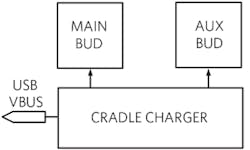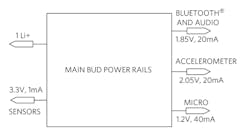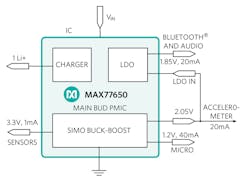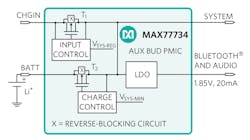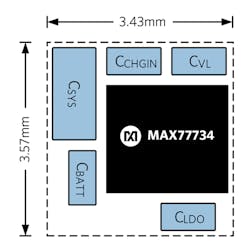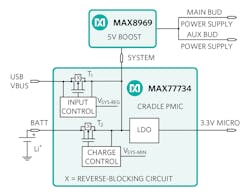Can You Hear Me Now? Extend the Life of Your Hearable Device
The fast-growing wireless earbud market was originally jump-started by mobile video and subsequently fueled by wireless stereo and fitness monitoring. The potential for innovation in hearable applications appears to be endless, as seen by new features such as biometrics, voice recognition, and noise cancellation.
1. Wireless earbuds in a charging cradle.
The miniature hearable system is comprised of the two earbuds and their charging cradle (Fig. 1). All three self-contained, battery-powered subsystems require careful partitioning, tight space utilization, and efficient use of the limited battery charge available. How do you enable more functionality while delivering power more efficiently in a tight space for a longer time? This article presents an innovative power-management system that delivers power in a very small space, while enabling longer battery life for each of the miniaturized elements of the hearable system.
The Hearable System
Figure 2 illustrates the hearable system, complete with earbuds and a cradle. The cradle receives power via the USB 5-V VBUS supply that charges the battery. When the buds are in place, the cradle powers the two buds, enabling their recharge even when untethered from VBUS. The main bud packs the electronics necessary for processing, wireless connection, audio amplification, and sensing, while the auxiliary bud powers the most basic functions of connection and audio.
2. Here’s a high-level diagram of a hearable system.
Earbud manufacturers currently specify three to five hours of playtime at 40% to 50% volume and 10 days of standby time with a 50-mAh battery. On the other hand, the requirement for the cradle to support five charges while untethered puts its battery capacity at around 500 mAh. The specifications are getting tougher over time, requiring innovative solutions that deliver more functionality for a longer time in a limited space.
Main Bud Power Rails
The block diagram in Figure 3 illustrates the rails necessary to power the main bud. Allowing for power-conversion inefficiencies in a worse-case scenario, the bud may draw as much as 80 mA with all of the loads simultaneously active. In this case, a 50-mAh battery would last only a bit more than a half hour. For the battery to last five playtime hours at 50% volume, virtually all of the blocks except Bluetooth and audio must be inactive. Clearly, this system needs tight power management to deliver to specification.
3. These are main bud power rails.
Similar considerations apply to the auxiliary bud and the cradle. Tight power management is required both in operation and standby states. Current solutions struggle to fulfill the space and battery-life requirements. A solution that delivers more power in a smaller space is necessary to enable more complex, more ergonomic, and longer-lasting hearable solutions.
Main Bud Power
4. Here’s the main bud power with the MAX77650.
The power-management IC (PMIC) in Figure 4 (MAX77650) integrates all of the required functions into one chip. The small PMIC eliminates the wasted space associated with using multiple packages. A single-inductor multiple-output (SIMO) buck-boost regulator implements three efficient switching regulators utilizing a single inductor, which reduces the overall solution size. In addition, high-frequency operation allows the use of a small inductor, further minimizing the required space. One LDO is on-chip for noise-sensitive loads. For simplicity, the external passives are not shown.
Auxiliary Bud Power
The PMIC in Figure 5 (MAX77734) integrates the essential functions for the auxiliary bud. The tiny PMIC’s linear battery charger implements Maxim’s Smart Power Selector circuitry to distribute power between the SYSTEM and the battery. The input control loop, in the presence of power to CHGIN, regulates the SYSTEM voltage to 4.5 V (VSYS-REG). The LDO and the battery charger (transistor T2 and its associated control) are both powered from the SYSTEM. In the absence of input power, the battery powers the LDO and the system loads via T2. In low-power mode, the IC consumes only 4.5 µA, which has practically no effect on the earbud’s required 10 days of standby time. In shutdown mode, the IC consumes less than 500 nA from BATT.
5. In this setup, auxiliary bud power leverages the MAX77734.
The solution layout in Figure 6 accounts for the active and passive components, except for three pullup resistors that are often integrated into the microcontroller. The total board space occupied is a mere 12.24 mm2.
6. This is an integrated charger and LDO footprint (12.24 mm2) with the MAX77734.
The small PMIC (2.23- × 1.97- × 0.5-mm WLP) powers the auxiliary bud, requiring minimal (best-in-class) PCB space.
Cradle Power
Figure 7 shows the cradle power system solution. The MAX77734 implements the cradle charger and 3.3-V microcontroller regulation, while the small and efficient MAX8969 boosts the SYS voltage to 5 V for both the main and auxiliary buds.
7. Illustrated is a cradle power system solution.
The PMIC and the boost converter (1.25- × 1.25-mm WLP) power the cradle, again requiring minimal (best-in-class) PCB space.
For additional design simplicity, the charger registers in the MAX77650 (main bud power) and MAX77734 (auxiliary bud and cradle) are identical, so the same set of firmware can be used for both.
Conclusion
A hearables set is a miniature system comprised of two earbuds and their charging cradle. The three self-contained, battery-powered subsystems pack increasingly more electronics into a very small space and must operate for several hours at a time.
Although traditional approaches require tradeoffs in terms of functionality versus electronics size, a new chipset helps solve the design constraints encountered with hearable devices. The MAX77650 with its SIMO architecture and the MAX77734 with its Smart Power Selector, together with the MAX8969 boost converter, efficiently deliver more power than before in a smaller space. The burgeoning functionality in hearables now becomes manageable since there’s a power solution to support it.
References:
Ultra-Low Power Tiny PMIC with Power Path Charger for Small Li+ and 150mA LDO
MAX77650 Ultra-Low Power PMIC with 3-Output SIMO and Charger Optimized for Small Li+
About the Author
Eric Rule
MTS, Mobile Power group
Eric Rule, MTS, joined the Mobile Power group at Maxim Integrated in January 2016 as an Applications Engineer. He validated the SIMO buck-boost architecture, linear charger, and linear regulators found in the MAX77650 and MAX77734, and develops hardware, software, and documentation for them. Eric’s work ensures that design with these products is easy and enjoyable for engineers. He graduated with a B.S. in Electrical Engineering from Cal Poly, San Luis Obispo.
Nazzareno Rossetti
PhD EE
Nazzareno (Reno) Rossetti, a PhD EE at Maxim Integrated, is a seasoned analog and power-management professional, a published author, and holds several patents in this field. He holds a doctorate in Electrical Engineering from Politecnico di Torino, Italy.
Sami Nijim
Senior MTS
Sami Nijim, Senior MTS, joined Maxim Integrated in 2013 and is product definer of the MAX77734 and MAX77650. He engineered and architected the MAX77650 SIMO behavioral model in SIMPLIS and wrote the specification for the linear charger found in both MAX77650 and MAX77734. Sami specializes in improving the customer hearable and wearable experience with tiny low-IQ power solutions. He holds a BSEE from Case Western Reserve University.


